William Dobson
William Dobson (4 March 1611 (baptised);[1] 28 October 1646 (buried)[2]) was a portraitist and one of the first notable English painters, praised by his contemporary John Aubrey as "the most excellent painter that England has yet bred".[3]

Biography
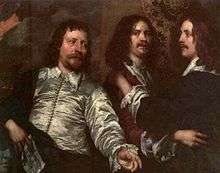

Dobson was born in London, the son of a lawyer also called William Dobson. He was apprenticed to William Peake and probably later joined the studio of Francis Cleyn. There is a claim that his father was a decorative artist, but this may be a misreading of the single known quote about Dobson Sr, by the antiquarian John Aubrey.[4] Dobson is believed to have had access to the Royal Collection and to have copied works by Titian and Anthony van Dyck, the court painter of King Charles I of England. The colour and texture of Dobson's work was influenced by Venetian art, but Van Dyck's style had little apparent influence on Dobson.[5] The story that Van Dyck himself discovered Dobson when he noticed one of the young artist's pictures in a London shop window is not supported by any evidence, nor do we know how he gained his introduction to the King, who had Dobson paint himself, his sons and members of the court.

Little is known of Dobson's career in the 1630s, but when Van Dyck died in 1641, the opportunity arose for him to gain royal commissions from King Charles. He is said to have become serjeant painter to the king and groom of the privy chamber.[2] However, this claim comes from only one old and as yet unverified source.[6] During the English Civil War Dobson was based at the Royalist centre of Oxford and painted many leading Cavaliers. His portrait of the future Charles II as Prince of Wales at the age of around twelve is a notable baroque composition, and perhaps his finest work. He also painted at least the head of Duke of York, as well as portraits of leading Royalists such as Charles Lucas and John Byron, Prince Rupert of the Rhine and Prince Maurice.
Works
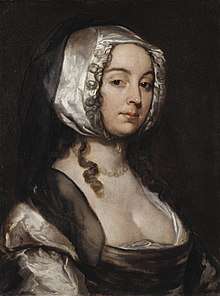
Around sixty of Dobson's works survive, mostly half-length portraits dating from 1642 or later. The thick impasto of his early work gave way to a mere skim of paint, perhaps reflecting a wartime scarcity of materials. After Oxford fell to the Parliamentarians, in June 1646, Dobson returned to London. Now without patronage, he was briefly imprisoned for debt and died in poverty at the age of thirty-five.
Ellis Waterhouse described Dobson as "the most distinguished purely British painter before Hogarth",[8] and in the view of Waldemar Januszczak he was "the first British born genius, the first truly dazzling English painter."[9]
There are examples of Dobson's work at the National Gallery, the National Gallery of Scotland, Tate Britain, the National Portrait Gallery, the National Maritime Museum, Queen's House in Greenwich, the Walker Art Gallery in Liverpool, the Ferens Art Gallery in Hull, the Courtauld Institute of Art, the Dulwich Picture Gallery in London, in several English country houses, and at the Dunedin Public Art Gallery in New Zealand.
The 2011 anniversary of his birth was marked by exhibitions, a 'Dobson Trail' listing his paintings on a website, and a BBC television profile by Januszczak, The Lost Genius of British Art: William Dobson.[10]
Personal life
He was married twice, first to Elizabeth, whose surname is unknown, as is the date of their marriage. She was buried in St Martin-in-the-Fields on 26 September 1634. On 18 December 1637 he married Judith Sander, who survived him.[2]
- William Dobson's paintings
 Charles II when Prince of Wales, circa 1642 or 1643.
Charles II when Prince of Wales, circa 1642 or 1643.
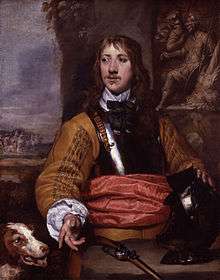
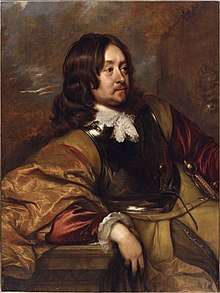 Edward Hyde Earl of Clarendon
Edward Hyde Earl of Clarendon%2C_1st_Bt.jpeg) Sir Richard Fanshawe (1608–1666), 1st Baronet
Sir Richard Fanshawe (1608–1666), 1st Baronet%2C_1st_Baronet_by_William_Dobson.jpeg) Sir Edward Dering (1598–1644), 1st Baronet
Sir Edward Dering (1598–1644), 1st Baronet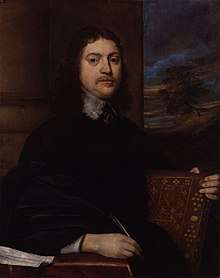 Nicholas Oudart
Nicholas Oudart Sir Thomas Aylesbury
Sir Thomas Aylesbury
References
- London Metropolitan Archives, St Andrew Holborn, Register of baptisms, 1558 - 1623, P82/AND2/A/001/MS06667, Item 001
- Katherine Gibson, William Dobson, Oxford Online Dictionary of National Biography, 2004
- National Portrait Gallery - William Dobson
- Jones, "The King's Painter", p27
- Waldemar Januszczak (Summer 2016). "The Full English". Bonhams Magazine (47): 29.
- Jones, "The King's Painter", p16.
- "William Dobson Portrait of the Artist's Wife c.1635–40". Tate Gallery. Retrieved 2 February 2015.
- E. K. Waterhouse, Painting in Britain 1530–1790, 5th edn, New Haven and London 1994, p.80, quoted in United Kingdom Tate Gallery — William Dobson 1611–1646, Portrait of the Artist's Wife circa 1635–1640.
- Waldemar Januszczak in part three of his BBC documentary series, Baroque! From St Peter's to St Paul's; and 'The first great British painter?' in Tate, 17, Spring 1999, p.62.
- William Dobson 1611–1646.
Further reading
- John Aubrey, Brief Lives.
- Waldemar Januszczak, The first great British painter?, Tate, 17, Spring 1999, p. 62.
- R. F. Jones, William Dobson: The King's Painter, Tyger's Head Books, 2016
- Malcolm Rogers, William Dobson, 1611–46: The Royalists at War, National Portrait Gallery Exhibition Catalogue, 1983.
External links
| Wikimedia Commons has media related to William Dobson. |
- Chisholm, Hugh, ed. (1911). . Encyclopædia Britannica (11th ed.). Cambridge University Press.
- United Kingdom National Portrait Gallery — William Dobson
- Tate Collection — William Dobson
- William Dobson 1611-1646, Biography, Paintings, Dobson Art Trail
- 59 paintings by or after William Dobson at the Art UK site